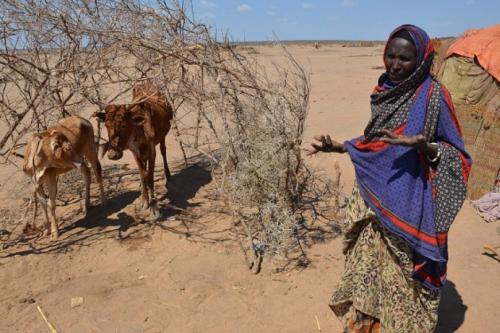Drought drives food price spike in East Africa, UN warns
East Africa’s ongoing drought has sharply curbed harvests and drive up the prices of cereals and other staple foods to unusually high levels, posing a heavy burden to households and special risks for pastoralists in the region, the United Nations agricultural agency said on Feb 14.

The most severe drought in decades has struck parts of Ethiopia, exacerbated by a particularly strong El Niño effect. This has led to successive failed harvests and widespread livestock deaths in some areas, and humanitarian needs have tripled since the beginning of 2015.
“Sharply increasing prices are severely constraining food access for large numbers of households with alarming consequences in terms of food insecurity,” said Mario Zappacosta, a senior economist for the UN Food and Agriculture Organization (FAO), in a news release.
Local prices of maize, sorghum and other cereals are near or at record levels in swathes of Ethiopia, Kenya, Somalia, South Sudan, Uganda and Tanzania, according to the latest Food Price Monitoring and Analysis Bulletin (FPMA).
Poor livestock body conditions due to pasture and water shortages and forcible culls mean animals command lower prices, leaving pastoralists with even less income to purchase basic foodstuffs.
Somalia’s maize and sorghum harvests are estimated to be 75 per cent down from their usual level. In Tanzania, maize prices in Arusha, Tanzania, have almost doubled since early 2016.
In South Sudan, food prices are now two to four times above their levels of a year earlier, while in Kenya, maize prices are up by around 30 per cent.
Beans now cost 40 per cent more in Kenya than a year earlier, while in Uganda, the prices of beans and cassava flour are both about 25 per cent higher than a year ago in the capital city, Kampala.
Drought-affected pastoral areas in the region face even harsher conditions. In Somalia, goat prices are up to 60 per cent lower than a year ago, while in pastoralist areas of Kenya the prices of goats declined by up to 30 per cent over the last 12 months.
Shortages of pasture and water caused livestock deaths and reduced body mass, prompting herders to sell animals while they can, as is also occurring in drought-wracked southern Ethiopia. This also pushes up the prices of milk, which is, for instance, up 40 per cent on the year in Somalia’s Gedo region.
Source:United Nations
- 273 reads
Human Rights
Ringing FOWPAL’s Peace Bell for the World:Nobel Peace Prize Laureates’ Visions and Actions

Protecting the World’s Cultural Diversity for a Sustainable Future

The Peace Bell Resonates at the 27th Eurasian Economic Summit

Declaration of World Day of the Power of Hope Endorsed by People in 158 Nations

Puppet Show I International Friendship Day 2020

